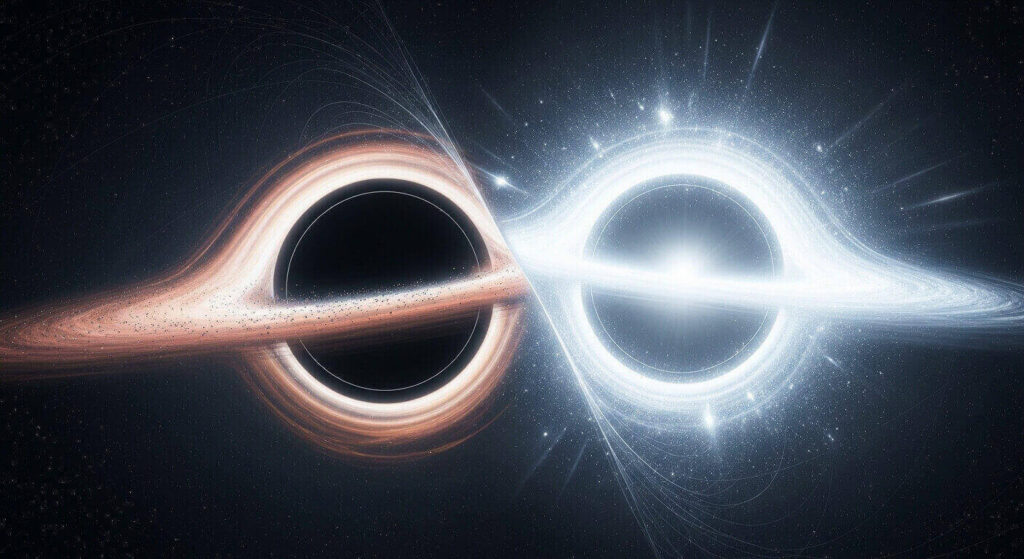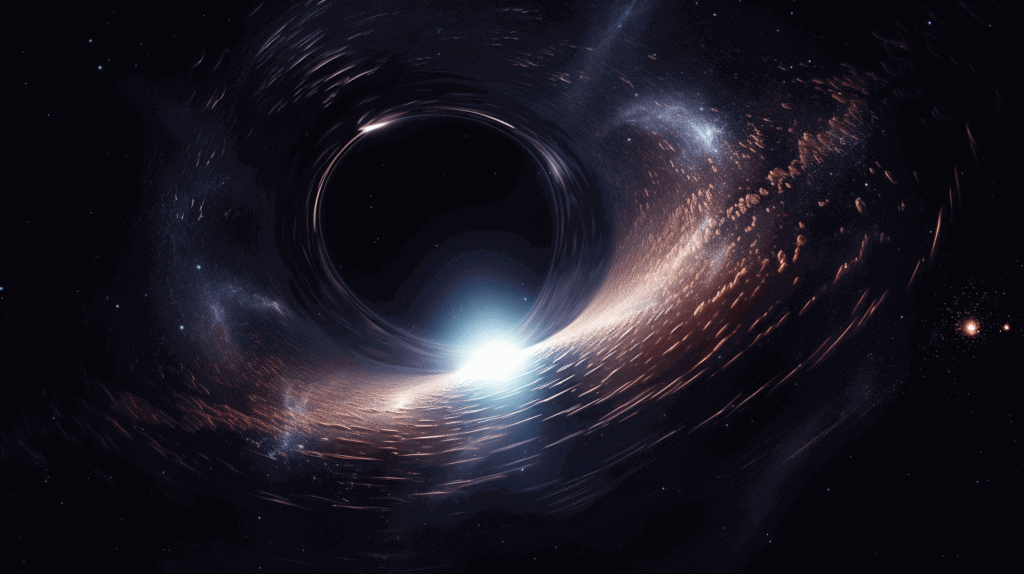Black Hole and White Hole: The Cosmic Twins? Explore the mind-bending theory of white holes, the explosive opposites of black holes. Are they just a mathematical ghost, or do they hold the key to the universe’s greatest mysteries?

In the vast, dark theater of the cosmos, no actor commands the stage quite like the black hole. It’s the ultimate cosmic villain, a gravitational monster that devours stars, galaxies, and even light itself. Once you cross its point of no return—the event horizon—there’s no escape. Everything is crushed into an infinitely dense point called a singularity. It feels like a one-way street to oblivion. But what if it isn’t? What if every cosmic entrance has an exit? This is where the story takes a fascinating turn, into the realm of a theoretical phantom: the white hole, the explosive, time-reversed twin of a black hole. Let’s dive in. 😊
Table of Contents
- What is a Black Hole? A Quick Refresher
- The Ghost in the Machine: The White Hole’s Mathematical Birth
- The Quantum Comeback: How a Black Hole Could Become a White Hole
- Searching for Evidence: Have We Ever Seen a White Hole?
- The Biggest Question: Is Our Universe a Giant White Hole?
- Conclusion: The Eternal Cosmic Dance
- Frequently Asked Questions About Black Holes and White Holes
What is a Black Hole? A Quick Refresher 🤔
Before we meet the ghost, let’s reacquaint ourselves with the monster. A black hole is born from the death of a massive star. When the star runs out of fuel, its core collapses under its own immense gravity, squeezing matter into an incredibly small space. This creates a gravitational field so powerful that its escape velocity exceeds the speed of light.
The “surface” of a black hole is the event horizon. It’s not a physical surface but an informational boundary. Anything that crosses it—starlight, planets, unlucky astronauts—is trapped forever. According to Einstein’s theory of general relativity, at the heart of the black hole lies a singularity, a point of zero volume and infinite density where our known laws of physics break down completely.
The Ghost in the Machine: The White Hole’s Mathematical Birth 📜
The idea of a black hole wasn’t born from an astronomer’s telescope but from a physicist’s pen. In 1915, while serving on the front lines of World War I, German physicist Karl Schwarzschild found the first exact solution to Einstein’s field equations. His solution perfectly described the spacetime around a non-rotating star, and in doing so, mathematically predicted the existence of black holes.
But there was something strange hidden in his equations. Many of the fundamental laws of physics possess “time-reversal symmetry,” meaning they work just as well forwards as they do backwards. A video of billiard balls colliding looks perfectly normal if played in reverse. Einstein’s equations were no different. If there was a solution describing matter falling *in* forever, there had to be a time-reversed solution describing matter flying *out* forever. That solution was the white hole.
⚠️ The Problem with White Holes
For decades, this idea was largely dismissed. A white hole, which spontaneously erupts with matter and energy, seemed to violate the Second Law of Thermodynamics. This law states that the total entropy (a measure of disorder) in the universe always increases. A black hole fits this perfectly—it takes in ordered matter and increases the overall disorder. A white hole does the opposite, creating order from chaos, which seemed physically impossible.
The Quantum Comeback: How a Black Hole Could Become a White Hole ⚛️
Just when the white hole was relegated to the dustbin of cosmic curiosities, it found a new life in a cutting-edge field: Loop Quantum Gravity (LQG). This theory attempts to unite general relativity with quantum mechanics by suggesting that spacetime itself is made of tiny, indivisible “pixels” or quanta, at the Planck scale (the smallest possible length).
In this picture, the singularity at a black hole’s center can’t exist. Matter can’t be crushed to an infinitely dense point because there’s a smallest possible unit of space. Instead, LQG predicts that the collapsing matter reaches a state of maximum, but finite, density called a “Planck star.” At this point, immense quantum pressure builds up, triggering a cataclysmic “quantum bounce.”
In that instant, the black hole transforms. The event horizon that only allowed things to fall in becomes one that only allows things to be ejected out. The black hole becomes a white hole. This elegantly solves several problems:
- No Singularity: The laws of physics are preserved.
- Information Paradox Solved: Stephen Hawking’s famous paradox asks what happens to the information about the matter a black hole consumes. If it’s destroyed, it violates quantum mechanics. In the quantum bounce model, the information isn’t destroyed; it’s simply held for a long time and then released.
- Thermodynamics is Safe: The white hole isn’t creating something from nothing; it’s releasing the processed remnants of what the black hole once swallowed, preserving the flow of entropy.
Searching for Evidence: Have We Ever Seen a White Hole? 🔭
If this theory is right, why don’t we see white holes everywhere? The answer lies in one of Einstein’s most profound discoveries: time dilation. Extreme gravity warps time. From our perspective outside the black hole, the quantum bounce process, which might take an instant inside the black hole, would be stretched out over billions, or even trillions, of years.
Essentially, we’re watching a cosmic event on an impossibly slow-motion replay. Most black holes that have ever formed may not have had enough time, from our vantage point, to make the transition yet.
💡 A Potential Candidate: GRB 060614
In 2006, astronomers detected a gamma-ray burst (GRB) unlike any other. Named GRB 060614, it lasted for over 100 seconds but lacked the typical supernova signature that should have accompanied it. The bizarre nature of this event led some scientists to speculate, cautiously, that it might be the signature of a tiny, primordial black hole finally undergoing its quantum bounce and exploding as a white hole.
Another intriguing idea is that the remnants of these ancient white holes could be a candidate for dark matter. If countless tiny black holes formed in the early universe and have since bounced, their stable, Planck-sized remnants would now be spread throughout the cosmos. They would have mass and exert gravity but would barely interact with light—the exact properties of the mysterious dark matter we’re searching for.
The Biggest Question: Is Our Universe a Giant White Hole? 🌌
Here’s where the theory becomes truly mind-blowing. Think about the description of a quantum bounce: a point of unimaginable density and energy suddenly exploding outwards, creating space and time as it expands. Sound familiar? It’s an almost perfect description of the Big Bang.
The “Big Bounce” hypothesis suggests our universe might be the result of a white hole explosion. What we call the Big Bang could have been the quantum bounce of a massive black hole that existed in a previous, parent universe. This would mean our universe isn’t a singular creation but part of an endless cycle of cosmic death and rebirth. The end of one universe inside a black hole becomes the beginning of the next as a white hole.
Conclusion: The Eternal Cosmic Dance 💃
The white hole remains a theoretical concept, a ghost haunting the equations of physics. But it’s a powerful one. It challenges our perception of endings and beginnings, suggesting they may be two sides of the same cosmic coin. The ultimate destination, the black hole, could also be the ultimate origin point.
While we wait for the evidence, the idea of the white hole offers a profound perspective. Our very existence might be the brilliant aftermath of a previous universe’s demise, a testament to a grand, cyclical nature we are only just beginning to comprehend. Perhaps our purpose is simply to be the universe’s way of witnessing its own magnificent, eternal dance of destruction and creation. What a show it is.

Frequently Asked Questions About Black Holes and White Holes ❓
Q: What is the main difference between a black hole and a white hole?
A: The simplest difference is the direction of causality. A black hole has an event horizon that you can only enter and never leave. A white hole is its exact opposite, featuring an event horizon that you can only exit and never enter. Black holes pull matter in; white holes hypothetically push matter out.
Q: Have scientists actually proven that white holes exist?
A: No, not at all. White holes remain purely theoretical. While they are a valid mathematical solution to Einstein’s field equations and fit nicely into theories like Loop Quantum Gravity, we have no direct observational evidence of their existence. Strange events like GRB 060614 are tantalizing hints, but they are far from proof.
Q: Could a black hole be a portal to a white hole in another universe?
A: This is the concept of a wormhole (or Einstein-Rosen bridge). Mathematically, connecting a black hole to a white hole is possible. However, such wormholes are predicted to be incredibly unstable and would collapse the instant anything tried to pass through them. So, while it’s a popular idea in science fiction, it’s not considered a viable method of travel by current physics.
Q: How does the “quantum bounce” solve the black hole information paradox?
A: The information paradox states that information cannot be destroyed, yet black holes seem to destroy it at the singularity. The quantum bounce model avoids this by eliminating the singularity. Information is instead compressed to an extreme state in a “Planck star” and is then ejected back into the universe when the black hole transitions into a white hole. The information is preserved, just scrambled and released over an immense timescale.
Q: If the Big Bang was a white hole, what does that mean for us?
A: It would mean that our universe is not a unique, one-time event but part of a potentially infinite cycle. This is the “Big Bounce” theory. It implies that before our universe, there was another universe that collapsed into a giant black hole. This cosmic cycle of birth, death, and rebirth suggests a universe that is eternal, constantly recycling itself.